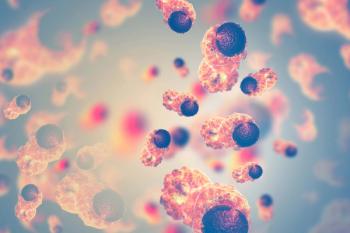
7-Gene Predictive Biosignature Helps Predict Ipsilateral Breast Cancer Recurrence
DCISionRT is a risk-assessment test for patients designed to predict RT benefit and develop their recurrence risk after surgery alone or with radiation.
Patients with breast cancer who have a high-risk clinicopathology but a low 10-year risk of ipsilateral breast recurrence (IBR) risk, determined via a 7-gene predictive biosignature, were not found to have a significant benefit from radiation therapy (RT), according to results that were presented during the 25th American Society of Breast Surgeons Annual Meeting.1
The signature, DCISionRT, identified the patient subset least likely to benefit from the additional treatment. Results showed that the 10-year IBR rate for all patients (n = 926) was 17.3% (95% CI, 13%-23%) for those who received breast-conserving surgery (BCS) vs 6.9% (95% CI, 5%-10%) for those who received BCS plus RT (HR, 0.4; P <.001). In the clinicopathologic high-risk groups, determined by RTOG-9804–like and Memorial Sloan Kettering Cancer Center (MSKCC)-like criteria, the 10-year IBR rates of 23.6% (95% CI, 16%-33%) and 21.1% (95% CI, 15%-29%) following BCS without RT compared with 7.6% (95% CI, 5%-12%) and 8.0% (95% CI, 5%-12%) for those who received BCS plus RT in each subgroup (HR, 0.3; P <.001; respectively). The absolute IBR rate reduction with RT was 16% (P <.001) and 13% (P <.01), respectively.
For patients in the low-risk subgroup (n = 338), the rate for BCS alone was 5.8% (95% CI, 3%-12%) vs 4.8% (95% CI, 3%-9%) for those receiving BCS plus RT (HR, 0.8; P = .7). The MSKCC-like criteria (n = 220) highlighted 10-year IBR for BCS alone of 6.8% (95% CI, 3%-16%) vs 4.8% (95% CI, 2%-11%) in BCS plus RT (HR, 0.6; P = .4). The rates for the RTOG-9804 criteria (n = 106) were 5.9% (95% CI, 2%-12%0 vs 3.0% (95% CI, 1%-12%) between both groups, respectively, (HR, 0.5; P = .5).
Patients in the biosignature high-risk group (n = 588) were found to have a 10-year IBR risk of 25.7% (95% CI, 19%-34%) after BCS vs 8.0% (95% CI, 6%-12%) in BCS plus RT (HR, 0.3; P <.001). For those who met the MSKCC criteria (n = 386), 30.2% (95% CI, 22%-41%) received BCS vs 9.2% (95% CI, 6%-15%) received BCS plus RT (HR, 0.3; P <.001). The RTOG-9804 classification (n = 347) had rates observed in those who received BCS of 30.5% (95% CI, 21%-43%) vs 8.7% (95% CI, 6%-14%) for those who had BCS plus RT (HR, 0.2; P <.001).
“Breast-conserving surgery followed by RT is considered standard management of patients with DCIS. However, we now realize that not all patients with DCIS will benefit from RT and there is a growing need to safely de-escalate treatment,” lead study author Julie Margenthaler, MD, FACS, professor of surgery, Washington University School of Medicine, and a surgeon at Siteman Cancer Center, stated in a news release about the findings.2 “DCISionRT is a valuable clinical tool that enables physicians to help identify which DCIS patients are most likely to benefit from RT based on the patient’s individual tumor biology and can help reduce over- or under-treatment.”
While breast-conserving surgery plus or minus RT is a standard approach for patients with ductal carcinoma in situ (DCIS), there is increasing interest in de-escalate therapy for patients given the greater than 95% breast cancer-specific survival rates, and traditional clinicopathologic factors do not properly identify patients with DCIS that are considered low risk.
DCISionRT is a risk-assessment test for patients with ductal carcinoma in situ designed to predict RT benefit by assessing tumor biology and other pathologic risk factors to develop their individual IBR risk following breast-conserving surgery either alone or plus RT. The test combines protein expression from 7 biomarkers and 4 clinicopathologic factors: age, size, palpability, and margin status.
In the trial, 926 women across 4 international cohorts who underwent breast-conserving surgery had their disease samples analyzed. Patients who were clinicopathologic low-risk were identified as having nuclear grade 1 to 2, a size smaller than 2.5 cm, and non-palpable and screen-detected and margin negative (RTOG-9804-like criteria), and low-risk score below 220 determined through nomogram weighted factors (MSKCC-like criteria), and patients who were clinicopathologic high-risk did not have these factors and were also classified into biosignature low risk (decision score [DS] ≥2.8 and no residual risk subtype [RRt]) or high risk (DS >2.8 plus or minus RRt).
When evaluated via RTOG-9804–like and MSKCC-like criteria, researchers found that 49% and 65% of patients, respectively, were identified as being in the clinicopathologic high-risk groups.
“The 7-gene predictive biosignature more reliably identified patients who benefited from RT compared with using traditional high-risk CP criteria (RTOG-9804-like, MSKCC-like),” Margenthaler and coinvestigators noted in the abstract. “Importantly, CP high-risk patients who were re-classified as biosignature low-risk had low 10-yr IBR rates and no significant difference with versus without RT.”
References
- Margenthaler JA, Vicini F, Shah C, et al. Limitations in utilizing clinicopathologic factors alone in identifying patients with dcis who benefit from radiotherapy after breast-conserving surgery. Presented at: 25th American Society of Breast Surgeons Annual Meeting; April 10-14, 2024; Orlando, FL.
- PreludeDx presents new data demonstrating utility of DCISionRTto de-escalate radiation therapy for women with DCIS. PreludeDX. News release. Published April 11, 2024. Accessed April 15, 2024.
Newsletter
Stay up to date on recent advances in the multidisciplinary approach to cancer.






























































































